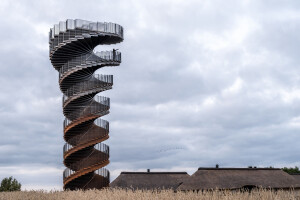Wangen Tower is the first multi-level and climbable structure to use self-shaped, structural timber components. The tower’s design and build is based on research from the Cluster of Excellence “Integrative Computational Design and Construction for Architecture” (IntCDC) at the University of Stuttgart. The tower was created as an architectural landmark and a pioneering timber structure for the Landesgartenschau 2024 (this large-scale, annual horticultural show takes place in different regions of Germany — the 2024 edition is in western Allgäu).
Wangen Tower connects the Landesgartenschau site in the Argen valley with the surrounding landscape. On the ground floor, the tower’s three entrances unfold between the timber surfaces in three directions, creating an inviting space for curious minds. Inside, as visitors climb the 113 steps of a steel spiral staircase, there is a sensorial connection with the materiality of the tower’s timber construction. On the viewing platform — a steel structure with glass panels — visitors are afforded views across the medieval town of Wangen im Allgäu and the Argen valley, and towards the Alps.
A pioneering timber structure
The 23-meter-tall (75-feet-tall) tower comprises twelve long structural segments — each segment is made from three individual cross-laminated timber (CLT) elements. These elements are 5-axis CNC machined — allowing for increased accuracy and precision — and joined using a newly developed mono-material lap joint. This works to “transmit forces in all directions, creating continuous CLT elements while maintaining constant cross-sectional dimensions,” says IntCDC.
The tower’s spiraling helix-like form and the curvature of its CLT surfaces create a novel surface-active timber structure that’s able to withstand horizontal wind loads. “The curvature provides additional stiffness to the timber surface, similar to a corrugated sheet,” explains IntCDC. “The central spine of the staircase supports the vertical live loads [the weight of people] on the steps and elegantly highlights the precise load distribution among the various structural components by tapering at the base.”
Computational design
Wangen Tower is a permanent research building whose design and construction was determined by computational design strategies used to integrate material behaviour and fabrication constraints. Professor Jan Knippers, Head of the Institute of Building Structures and Structural Design at the University of Stuttgart, explains: “The innovation in timber construction is enabled by an integrative approach to scientific research, materially-informed computational design, digital fabrication, and expert craftsmanship.” Wangen Tower was designed, certified, and constructed over the course of a year. Meticulous prefabrication — with millimeter accuracy and CNC-milled timber connection details — ensured the tower’s on-site assembly was completed in just three days.
Self-shaped timber
Wangen Tower’s curved timber components are based on the large-scale, self-shaping manufacturing that is derived from the moisture-induced shrinking of wood. “Typically, moisture-induced shrinkage and deformation is considered undesirable in timber construction,” says IntCDC. “However, inspired by biological examples, like the spruce cone which reacts to changing ambient humidity levels with a shape change of its scales, similar principles can be applied to control the self-forming of curved timber components.” The tower’s curved timber elements are derived from a computationally predetermined target curvature, driven by the characteristic shrinkage of wood during a standard industrial drying process.
Self-shaped elements in preparation for CLT gluing:
Screw press gluing of the lap joint between CLT components:
A complete raw segment of the tower:
Pre-installation of the larch facade:
Tower segments in a protective cover ready for transport:
A pair of tower segments being transported to the site:
The tower’s self-shaped CLT components are made with locally sourced spruce. IntCDC explains the self-shaping process:
“Self-shaping bilayer plates are designed and produced as flat panels, each consisting of a 30-millimeter-thick ‘active’ layer and a cross-laminated 10-millimeter-thin ‘restrictive’ layer. The wood boards are processed after slight air-drying and the ‘active’ layer, with a higher moisture content, is laminated to the restrictive layer in a flat vacuum press.
After lamination, the flat plates undergo a controlled kiln-drying process where the active layer shrinks perpendicularly to the fiber direction of its boards, effectively shaping the panels into their predicted curved form.
Three self-shaped bilayer plates and a 10-millimeter-thin elastically bent locking layer are stacked and laminated to create a final, dimensionally stable, and accurately curved 130-millimeter-thin CLT panel.”
Assembly
The twelve long structural segments were pre-assembled in sets of two, thereby minimizing on-site construction time (to three days). Steel connectors (between the CLT structure and the staircase) and the majority of the facade’s 168 individually crafted larch panels, were pre-mounted in the factory. The tower’s components were installed on-site on a shallow foundation made from recycled concrete with CO2-reduced cement. The spiral staircase and viewing platform were inserted into the tower from above.
Erection of the first two pairs of tower segments on-site:
Construction of Wangen Tower's load-bearing CLT structure:
Installation of the viewing platform:
“The distinctive expression of the tower’s unique timber structure stands as a testament to the latent design possibilities in naturally renewable, locally sourced, regionally manufactured, and resource-effective timber architecture,” says Professor Achim Menges, Director of Cluster of Excellence IntCDC.
Wangen Tower details
Height: approx. 23 meters (75 feet)
Footprint: 50 square meters (538 square feet)
Viewing tower diameter: 5.6 meters (18 feet)
Foundation: recycled concrete with CO2-reduced cement
Timber structure: twelve curved CLT panels with 130-millimeter thickness and a total surface area of 360 square meters (3,875 square feet)
Staircase: hot-dip galvanized steel spiral staircase with 113 steps
Viewing platform: hot-dip galvanized steel structure with glass panels
Project partners
Cluster of Excellence IntCDC — Integrative Computational Design and Construction for Architecture, University of Stuttgart
Institute for Computational Design and Construction (ICD): Prof. Achim Menges, Martin Alvarez, Monika Göbel, Laura Kiesewetter, David Stieler, and Dr. Dylan Wood, with the support of Gonzalo Muñoz Guerrero, Alina Turean, and Aaron Wagner
Institute of Building Structures and Structural Design (ITKE): Prof. Dr. Jan Knippers and Gregor Neubauer
Blumer-Lehmann AG: Katharina Lehmann, David Riggenbach, and Jan Gantenbein
Biedenkapp Stahlbau GmbH: Markus Reischmann and Frank Jahr
Stadt Wangen im Allgäu — Landesgartenschau Wangen im Allgäu 2024 GmbH









































































